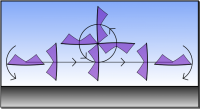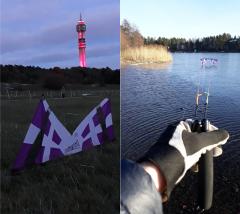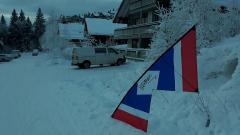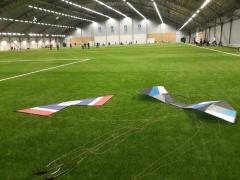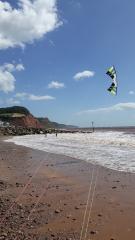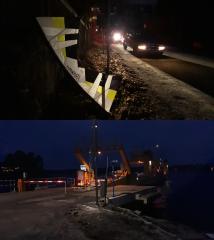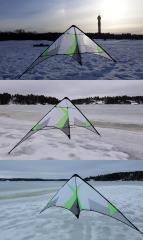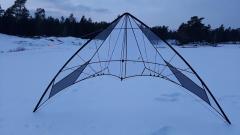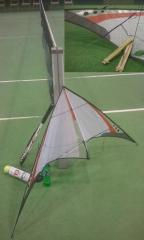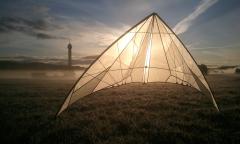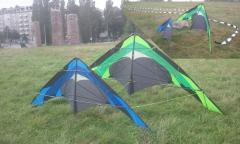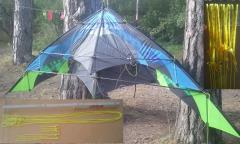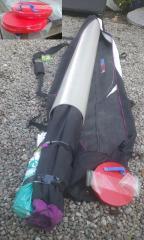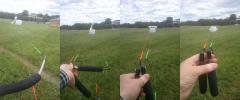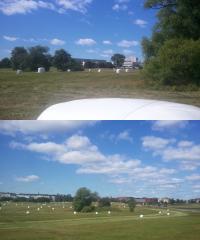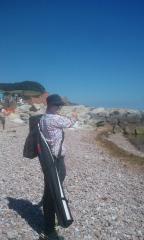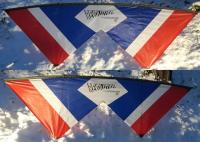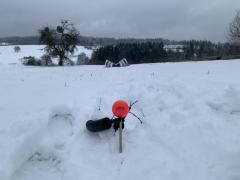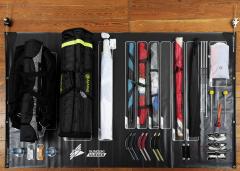-
Posts
580 -
Joined
-
Last visited
-
Days Won
27
Content Type
Profiles
Forums
Gallery
Downloads
KL Shop
Blogs
Articles
Everything posted by Exult
-
Thank you for this genuinely interesting story though it obviously got a very sad element. Initially I was a bit confused how a 40 inch kite could lift a man before I realized that the unit was foot and that the kite was large (and the lifting surface was large squared). Welcome to the forum!
-
Don’t ruin my sleep with horror stories like this 🙂. Though we haven’t got USPS over here there is always room for worrying (have had some delivery problems when buying stuff, but haven't lost anything though). I have for the first time, ordered custom made kites that should be shipped by end of February (about now). Not one QLK, but two to add to my lo/no wind quad armada (now limited (as in numbers!) to a Rev Indoor and a B-series std). My anticipation has now been replaced with unease and fear. 😬😨😱 Tough conditions! Hope it gets resolved in some way!
-
Wing pivot circle + 180 deg team/down turn – repeat, repeat, repeat... A figure to learn by cycling through it again and again... The Pre-drill - Just Going Back and Forth Left to Right... A “pre-drill” is just to go horizontally left-right-left and turning by doing 180 deg down turns ( https://www.youtube.com/watch?v=SD1JAGY06ZE&feature=youtu.be ). Not so horizontal straight paths? - Just keep going! Happened to come close the limit of the available area (edge of the “field” or parking or a wall)? - Adjust the length of the horizontal paths/and position of the 180deg turns so that you can return (yourself) to the centre of the available area. Adding the Wing Tip Pivot Circle Since this figure repeats, reaching the “five repetitions” doesn’t take a very long time. Next add the wing pivot circle between the two 180deg turns. The centre of the added circle should be the top wing tip (of the horizontal path) ideally. Pull lower/outer wing forward without changing the handle angle much – just let the the lower half trailing edge out the slightest. When you have just started the upwards turn of the circle a little, add some pressure on both left and right handle to sort of lift the kite through the going upwards part of the circle. Kind of just lifting the kite over the top of the circle. If needed to get up more from the ground, deform the circle so that the going up part becomes a bit longer (larger radius) by making the pull on both sides more similar. Set the goal to (after many sessions?) be able to also do the figure quickly, snappy, precisely and feeling the pull from your efficient drive of the kite. Of course the circle can be replaced with a square, rhomb, etc... as a variation. Personally I now work with the speed/snappiness and making a quick horizontal exit from the circle. Then when going left to right, for some reason, I tend to deviate somewhat upwards at the end of the circle. What do you think is the most challenging part of this exercise?
- 11 replies
-
- indoor
- short line
-
(and 3 more)
Tagged with:
-
Learning to control the powered state by light wind The “powered control” during “pulsed mode forward flight” tugging (as discussed in the previous post) on the lines can also be approached from a different direction. As a believer in approaching learning from many directions, contexts, conditions and kites I can see a value in piloting the Rev Indoor also in (quite) light wind, making it just slightly over powered (giving a lump-of-butter-in-the-frying-pan feeling of little-input-in-much-output-out, but still hopefully in control). You can then get used to this powered state of the Rev Indoor without needing to focus on pumping the kite/tugging on the lines. The “light wind” I refer to here doesn’t make 360ies close to the ground difficult, but is enough to bend the Rev Indoor LE when flying forwards a bit up from the ground. So the next time these low wind conditions are offered, don’t curse them for not being proper indoor conditions, instead rejoice that you now can practice this aspect of kite piloting – beneficial both for indoor and (std) outdoor quad-line kiting. I’ve heard expressions like "flying brake heavy", "load the sail" ( ) or "feeling the pressure". The latest expression I’ve heard is “flying on brakes” on a power kiting forum ( https://kiteforum.com/viewtopic.php?f=6&t=2401189 : “What it means is to generate the maximum power from that kite you have to keep some pressure on the brake lines.” (more than only to avoid trailing edge fluttering I would believe). There is no separate set of laws of nature for an indoor kite, just the requirement that you must be a little more efficient in the usage of the wind (that you in this case mostly generate yourself). I sense a similarity here, both for power and indoor kiting the kite should generate pull (and/or make efficient use of the wing) and is most often moving forward. Artistic hovers – not so much in either discipline. However in no/low wind the conditions around the (indoor) kite will rapidly change with your tugging the lines and changing tempo/power input and of course you need to constantly compensate for this.
- 11 replies
-
- 2
-

-

-
- indoor
- short line
-
(and 3 more)
Tagged with:
-

Taking the plunge, blue & green for my lights (went with dark+florescent green)
Exult replied to frob's topic in Kite Making
Looking forward to see the future details of this project, especially observations/comments/details about the permanent LED installation (though my own LED test was limited to clips only...). How much will lower wind range performance be affected e.g.? Imagine KL becoming a kite building forum (i.e. many build projects lately on KL)? -

Catching_QuadKite_PabloModels.jpg
Exult commented on PabloModels's gallery image in Member's Galleries
-
There are no dimensions mentioned in this discussion - Like the average value of a series of caliper measurements of the inner/outer diameter and wall thickness (and tube length). Whether this is because of people in general not having a caliper at home, that is considered bad practice to share too much data on non-open designs or if feeling unhappy about not knowing about the legal aspects (or just being aware of the unsymmetrical relationship between a private person versus a company) I don't know. Nonetheless, without the dimensions the discussion becomes quite limited.
-
Speeding the kite up – not yourself so much, while focusing on the pressure This exercise is about finding the handle angle/adjustment when the kite functions like an efficient wing moving forward with a high glide ratio (I’d guess) by maximizing the pressure you feel in your hands. This is essential for no/low wind powered flight with tight lines both when traveling in a straight path (forwards and backwards) or during various turns of the kite (thus exceptions are: ground gaining glides, catches&throws, hovers, axels…). The exercise is also good as a session warning up exercise as a preparation for the turns, figures and start and stops of the session. Without a basic ability to fly the quad as an efficient moving wing generating lift, no-wind kiting is not so fun in the long run, very exhausting and offer mostly poor control. How to start out doing this exercise “Zoom around” with the kite doing no specific figures, but keep the kite going forward constantly. Leave the sharp turns and starts and stops to later. Adjust the angle of the handles by applying maximum brake until, but not beyond the point when the speed forwards would drop. Focus on the pressure that you now get in your hands – both when going straight forward and in turns. Try to maintain a constant pressure both by moving around on the ground and by using your arms. Test that you are at the maximum pressure for various kite speeds) e.g. by making the tiniest adjustments in the pressure of your ring fingers e.g. Then compare propelling the kite with constant velocity and by cyclic tugging of the lines (“leaping mode”) You (and your hands) moving away from the kite in the direction of the lines is what counts as a motor source. After a while, do single or series of light tugs (like one every second) on all four lines without (intending) changing the angle of the handles (much). When I looking carefully what happens here, the trailing edge *and* the down spars actually flexes out slightly when tugging on all four lines. The small corresponding tilting of the handle when tugging is a natural effect of holding the handles as close to the top leader as possible. Feel and observe the response in the sail/lines with the kite heading in various directions. Added 6th of February-2021: Don’t be afraid to also cause the LE to flex rather much when tugging. It is kind of a receipt of that you are doing well. (always pulling softly on the lines is like playing the piano with certain keys removed) Getting the kite moving so that it can function as a wing With the kite travelling parallel to the ground as when doing 360ies (or when initiating forward horizontal movement): If the kite is not moving forward enough (to function well as a wing), briefly let go of the trailing edge just a fraction to get to get it moving (and/or make a light short tug on the lines). The input is much like the input than you do on one side in a minor course correction (e.g. when going parallel and close to the ground). Instead of very lightly releasing of the brake on the one side you want to bring forward, now release brakes on both sides briefly (like 0.5s). Before the kite is going forwards you need to be backing a bit faster from the kite. If on longer lines, also use the upper parts of the “wind” half-sphere window While at it moving yourself around, let the kite be (and remain) in places where you don’t tend to position it so frequently otherwise. I have a tendency in almost all forms of dual and quad kiting to be closer to the ground (looking horizontally is more comfortable than looking upwards). Though for the (short) 4.6m (15ft) lines, the zenith (top of sphere) is easy to reach and space so limited, that this “kite is close to ground tendency” is less pronounced. Getting used to being high up is also useful for getting up and overs on the 8.2m (27ft) lines that will not drive my hands too low towards the ground. I most often use the the Rev Indoor for no/low wind doing street kiting on 8.2m 40kg lines (27ft 88pound) . Sometimes I use the Rev B-series 1.5 std when no/low wind street kiting, but not for any long sessions. At least when starting with the “finding the pressure exercise”, the Rev Indoor provides the most obvious pressure (variations) feedback (because being an indoor kite I suppose). On the other hand the Rev 1.5 std gives much more physical exercise in low wind. Ok, this post was a bit lengthy, but there are many aspects of the brake heavy efficient use of the sail. This is applicable to most things you’ll doing during the session.
- 11 replies
-
- indoor
- short line
-
(and 3 more)
Tagged with:
-
That's fine, I was also a lurker for quite some time before joining. For 40 years and join to learn, how very humble. Welcome!
-
From the album: Exult's Photos
An Early Autumn Evening Session The wind had gradually died out during the evening, but I was determined go on as long as possible (or too lazy) without switching to the std. A January Afternoon Session Rev B-series midvent on 25m (82ft) lines two weekends ago. The very thin ice had small holes in it here and there and when landed, the downspars had a slight tendency to slide away. When sliding sideways on the ice with the LE downwards, the dacron against the ice could be heard. It was a nice winter day, quite mild and warm for being this time of the year. Simon and Garfunkel, Slip Slidin’ Away: https://www.youtube.com/watch?v=ZNt5FnMK2sM -
-
To a very productive person!: The man, the myth, the production facility! 🙂 (Non-kitespecific artwork mostly from https://freesvg.org/ ) factory3.pdf
-
From the album: Exult's Photos
Quite close to zero wind, but there were also a few gusts overpowering the kite. Was at the time thinking about what exercises I tend to do ( https://kitelife.com/forum/topic/10646-what-are-your-current-most-rewarding-indooroutdoor-%E2%80%9Cnegligible%E2%80%9D-wind-short-line-drills/ ) and the effects of switching to the shorter line set (4.6m, 15ft). -
Would this be tight enough? I have arranged the light (left right) so that crests/folds should be more visible: I’m a bit lost here - what tension should I expect to be the best for a no/low wind kite? Losing contact with the sail by too much slack obviously doesn’t sound good for the control. On the other side the sails on yachts and low speed (thin) airfoils typically got a camber towards the LE. Shouldn’t reducing the tension create more billow/camber and therefore function more efficiently as a wing? Is a camber formed by the LE flexing (by tensioning by bungee pre-tensioning or by tugging the lines) or could it instead be sewn into the sail? Two (non-QLK) kites with a billow that stands out are: the Speedwing (pulls much) and the Kymera (the wind window feels wider than my other DLKs).
- 11 replies
-
- indoor
- short line
-
(and 3 more)
Tagged with:
-
I have said it before ( https://kitelife.com/forum/topic/8756-a-first-model-kite-probing-the-kite-building-ground/?do=findComment&comment=70719&_rid=10687 ) and I say it again “SLKs are scaaary - personally I'd wouldn't like to meet one in a dark alley...🙂”. As a quad and dual line pilot I find these SLKs a mystery. However, some day I intend to learn… Keep up the good work and get challenge/experience by whatever nature decides to throw on you!
-
I think that your windless video gives a very relaxed effortless impression that plays well with the soft music. Smoooth!! Agree on feeling the pressure when backing the kite is important – Comment aimed at breaking the silly-analogy-barrier of the initial post: I for some reason at an early stage of indoor piloting imagined the backing kite being a slowly moving powerful locomotive. Also did the “Watty adjustments” at an early stage. I can’t compare/remember/refer to how it was before them because I knew too little no wind piloting at the time after the first few sessions. I think initially, the first sessions, everything goes wrong no matter what the adjustments. So therefore I wonder what are the effects of increasing the tension of the LE? Easier to reverse the kite and more? That’s nice when gaining experience by transferring drills to other circumstances. Yesterday I went the other way and tried an no wind “mini-figure” on 25m lines (82ft) using and 1.5 B-series mid vent. Since the context was so different the mini-figure turned out to be more difficult than expected (and therefore good as an exercise). When switching to 15m lines (49ft) it felt more familiar and was easier again. I think it is worth mentioning in the context of reversed 360-ies how to initiate reverse flight by turning upwards from horizontal flying to having the LE horizontally and then start the backing downwards first. A variation of the theme (as displayed in the video) is to fly horizontally forwards and then change direction while just maintaining the orientation of the kite.
- 11 replies
-
- indoor
- short line
-
(and 3 more)
Tagged with:
-
-
-
-
That’s one way of doing it that I haven’t tried yet.
-
How exotic 🙂 – the goo on the kite equipment around here tends to be more mud and dirt! There are no natural beaches close to where I live, only an artificial small one at the edge of one of the fields/kiting sites. Contact with the sand can mostly be avoided there if the kite/kiting gear would get wet.
-
What are you focusing on now? Which exercises or figures are you returning to? What is learned from them? A post of yours regarding a certain exercise might include (baked in) answers to a few of these questions: What are you working on now/recently? What did you learn and how did you do it? What do you think your hands/body were doing (if you were successful)? Why is it a good exercise for you? What was the feeling? Come on don’t be shy – even the silliest comparison/analogy/image might talk to someone. What were the necessary steps/skills/realizations before this exercise? What kite and line length do you prefer to use for the drill? What are the most favourable conditions to start out doing the exercise? Are there any other exercises or context in any form of kiting where your recently gained wisdoms are applicable to, like medium wind kiting with longer lines or perhaps kiting with another number of lines? If you didn’t post the exercise, but instead tried to follow the advice given, how did it go, are there any remaining question marks? Can something be described in another way? Perhaps you want to repeat an exercise suggestion, but in your way? It is fine to return to this topic if you realize something more about a drill/exercise half a year later or so, whether you originally posted the suggested exercise or not. 1, 2 or 4 lines are all fine, but consider to clarify if not obvious. Typically used line length? Without knowing it, you might be holding a piece of somebody's puzzle or provide an exercise that unlocks another ability for someone. Expressing something for someone else clarifies it for yourself as well. Sing it out!!
- 11 replies
-
- indoor
- short line
-
(and 3 more)
Tagged with:
-
Is there a purpose of the white stuff/paint/goo on the handles? Added to make it less prone to snag (catch the kite lines)?
-
Could it be that in the menu on the R-Sky web shop that the Nirvana is listed under “Polyvalent” (versatile) and not under the perhaps more familiar “Freestyle” or “Précision”, that makes it less obvious to find? I get the impression (and they state something similar) that they wants to move on and not be locked into being the Nirvana company only while still referring to the old successful design. Nirvana occurs only one time in in the menu along kites like Nirvana 3E (third edition), NSE (second?). Often the names of other models names starts with an “N” (“Next” and “NFX”). Sorry to ask, but have you tried to: use the web contact form, use the e-mail address ou téléphonez-leur (which personally would terrify me due to my severe lack of french conversational practice 😬)? Just saw that Bilboquet (in France as well) sells both the NSE and Nirvana 3E and other R-Sky models.
-
Seriously well organized! – Should ensure that none of the essential stuff is forgotten at home. My pre-session organisation is mostly limited to keeping my kite lines etc in a plastic bags: one for short no/low wind quads indoors or street, one for quads on a “proper” field and one for dual lines). The kites to bring I mostly pick on a wind/session basis. How was this roll-up bag made (or is it more of a packing list?)? I like the area for the snack – a small piece of chocolate that can allow one to go on for an hour extra if required. A chocolate bar is also well wrapped to be handled by “muddy field fingers” and during summer hopefully preventing fat stains on the kites in case the chocolate would melt.

